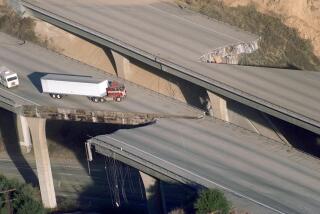Leon Knopoff dies at 85; UCLA scientist who applied computer modeling in earthquake research
Leon Knopoff, a UCLA researcher who was widely regarded as the father of theoretical seismology, died of respiratory failure Jan. 20 at his home in Sherman Oaks. He was 85.
Knopoff did pioneering research in “how an earthquake works,” said his colleague, UCLA geophysicist Paul M. Davis. “He demonstrated that an earthquake can be represented in terms of forces … then reduced it to a much simpler mathematical model of forces acting within the Earth.”
He was among the first to apply computer modeling to earthquakes, using applied mathematics to develop sophisticated representations of what was happening beneath the Earth’s surface. He was able to demonstrate that many classical solutions in mathematics could be applied to earthquakes as well.
With his colleague Robert Burridge, he constructed two-dimensional models of earthquakes using masses attached to springs, called the slider model, to serve as a basis for earthquake simulations. These devices, operated physically or simulated in a computer, demonstrated that earthquakes tend to occur in clusters.
That discovery allows researchers to forecast earthquakes with some confidence but not to predict them with certainty. For example, there is about a one in 20 chance that any quake is a foreshock of a large temblor.
Knopoff also found that most small earthquakes on a major fault relieve stress but are not predictors of a subsequent instability, and thus do not help in forecasting future events.
He also gained a certain amount of fame from a 1983 report in the journal Nature with astronomer Steven Kilston that tentatively linked earthquakes to an alignment of the sun and moon on opposite sides of the Earth that tugged the opposite sides of faults in opposing directions. That article predicted a quake in November 1987 in California’s Imperial Valley and, in fact, two occurred.
Researchers still do not know what to make of that potential link.
Knopoff was also the co-inventor of thermoluminescence dating, widely used by archaeologists to determine the age of pottery. Heating the crystalline materials releases radiation trapped during the time since the pottery was produced, emitting light whose intensity is directly proportional to the age of the object.
A talented pianist and harpsichordist, Knopoff was also a member of UCLA’s music department, where he applied the same intellectual rigor to the analysis of music as he did to science. With William Hutchinson, he published a series of papers on psychoacoustics, which analyzed human psychological responses to various components of music, such as consonance, dissonance and harmonic structure.
And in the same way that some literary analysts used computer analysis and pattern recognition to identify the idiosyncratic speech patterns of individual authors so that they might determine, for example, if a specific play was written by Shakespeare, he performed pattern analysis on musical compositions so that if a previously unknown composition were discovered, it might be possible to identify its composer.
Leon Knopoff was born July 1, 1925, in Los Angeles. He received his bachelor’s degree in physics in 1944 and his doctorate in 1948, both from Caltech. After two years at Miami University of Ohio, he joined UCLA, where he spent the rest of his career.
He was the author of more than 350 research papers, co-editor of five books, and winner of numerous awards and honorary doctorates.
In 2001, Knopoff and his wife endowed the Leon and Joanne V.C. Knopoff Career Development Chair in Physics and Geophysics, the first chair in the basic sciences to be endowed by a faculty member during the Campaign UCLA fundraising program. “Joanne and I have benefited so much from being at UCLA that we would like to return the favor,” he said of the $500,000 donation. “Our lives revolve around UCLA.”
In addition to his wife, the former Joanne Van Cleef, he is survived by a son, Michael; two daughters, Rachel Knopoff and Katie Knopoff Wadley; and a grandson.






